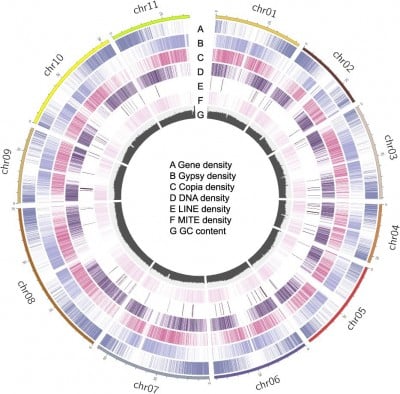Science
Researchers Map First Gap-Free Mung Bean Genome for Breeding Insights

A team of researchers has successfully produced the first **telomere-to-telomere** (T2T) genome of the mung bean, or **Vigna radiata**. This groundbreaking development reveals how structural variations have influenced the plant’s domestication and adaptation. The study utilized advanced sequencing technologies, including **PacBio HiFi**, **Oxford Nanopore**, and **Hi-C**, to create a comprehensive view of the mung bean’s genetic makeup.
The findings highlight significant genetic changes linked to **plant architecture**, **stress response**, and **metabolic pathways**. The research indicates that the amplification of transposable elements has notably reshaped nearby gene expression. Notably, genes involved in **fatty acid synthesis**, **suberin formation**, and **phenylpropanoid metabolism** displayed strong selection pressures throughout the evolution of this vital crop.
Implications for Future Breeding Programs
This comprehensive genome serves as a critical resource for understanding the evolutionary history of the mung bean. According to the research team, the insights gained will aid in guiding molecular breeding efforts aimed at enhancing crop yield and resilience. Mung beans are crucial in many agricultural systems, particularly in Asia, where they are valued for their nutritional benefits and environmental adaptability.
Understanding the genetic basis of mung bean traits can facilitate the development of improved varieties that withstand stressors such as drought and pests. The research underscores the importance of utilizing advanced genomic technologies in plant breeding. As global food demand continues to rise, such innovations are essential for ensuring food security.
Furthermore, the study emphasizes the role of detailed genomic information in breeding programs. By identifying specific genes that contribute to desirable traits, breeders can make informed decisions to enhance crop performance. This research not only contributes to the scientific community’s understanding of mung bean evolution but also has practical implications for farmers and agricultural stakeholders.
In conclusion, the creation of the gap-free genome of **Vigna radiata** represents a significant advancement in plant genomics. The integration of multiple sequencing technologies has provided a wealth of information that can be leveraged for future breeding initiatives. As researchers continue to explore the genetic landscape of mung beans, the potential for cultivating more resilient and productive varieties is becoming increasingly tangible.
-

 Science2 months ago
Science2 months agoInventor Achieves Breakthrough with 2 Billion FPS Laser Video
-

 Top Stories2 months ago
Top Stories2 months agoCharlie Sheen’s New Romance: ‘Glowing’ with Younger Partner
-

 Health2 months ago
Health2 months agoCommunity Unites for 7th Annual Into the Light Walk for Mental Health
-

 Entertainment2 months ago
Entertainment2 months agoDua Lipa Aces GCSE Spanish, Sparks Super Bowl Buzz with Fans
-

 Health2 months ago
Health2 months agoCurium Group, PeptiDream, and PDRadiopharma Launch Key Cancer Trial
-

 Top Stories2 months ago
Top Stories2 months agoFormer Mozilla CMO Launches AI-Driven Cannabis Cocktail Brand Fast
-

 Entertainment2 months ago
Entertainment2 months agoMother Fights to Reunite with Children After Kidnapping in New Drama
-

 World2 months ago
World2 months agoIsrael Reopens Rafah Crossing After Hostage Remains Returned
-

 World2 months ago
World2 months agoR&B Icon D’Angelo Dies at 51, Leaving Lasting Legacy
-

 Business2 months ago
Business2 months agoTyler Technologies Set to Reveal Q3 Earnings on October 22
-

 Health2 months ago
Health2 months agoYouTube Launches New Mental Health Tools for Teen Users
-

 Health2 months ago
Health2 months agoNorth Carolina’s Biotech Boom: Billions in New Investments









